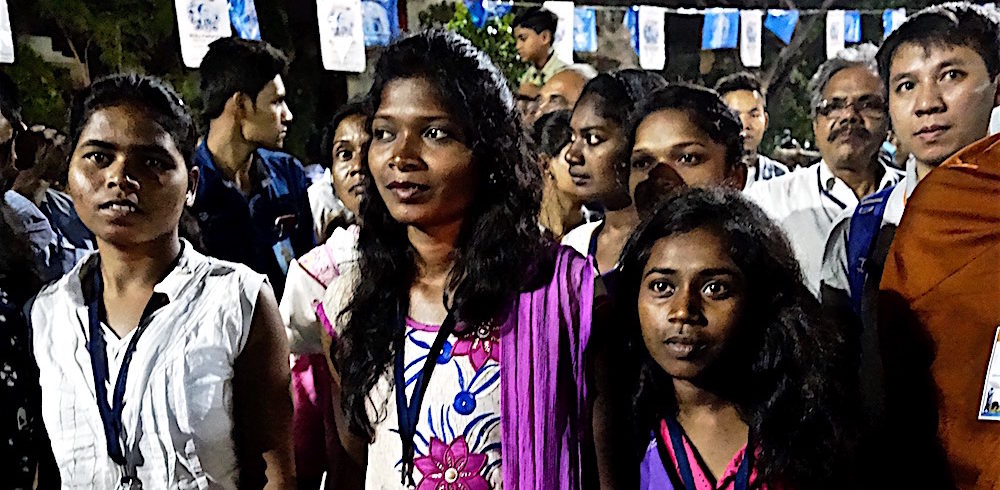Posted on August 28, 2011 by Alan Senauke
Mindfulness & Ethics — Notes from Hamburg’s Int’l Mindfulness Congress

At the end of last week’s International Mindfulness Congress in Hamburg, His Holiness the Dalai Lama was asked whether the practice of mindfulness is inherently ethical. This was, I think, the pressing and recurring question of our conference, which brought together Buddhist teachers, neuroscientists, doctor, psychologists, educators, and even one or two activists. His Holiness, echoing the comments of professor Alan Wallace’s opening keynote, said that even a suicide bomber would likely have to cultivate some sort of “mindfulness.”
He went on to explain that all religious traditions, as well as most societies — secular or religious — are based on ethical systems. (Of course, these ethical systems may have their own gaps or blind spots.). In terms of Buddhism, there is a simple distinction. The Buddha’s path speaks of RIGHT mindfulness (sammasati), not the technique of mindfulness.
The Noble Eightfold Path, which is more circular than linear, is traditionally divided into three interdependent sections: sila or ethics (right action, speech, and livelihood), samadhi or meditation (right effort, mindfulness, and concentration or meditation), and prajna or wisdom (right view and right understanding).
So the essential adjective is right/samma. In the west “right” is tangled up with “righteous,” which carries with it an Old Testament sense of judgment and duality. Samma might have the sense of skillful or wholehearted. However we choose to translate it, samma points towards awakening or liberation of beings, which depends on practicing the whole path of sila/samadhi/prajna.
Buddhist scholar Andrew Olendzki writes:
True mindfulness is deeply and inextricably embedded in the notion of wholesomeness… Just as a tree removed from the forest is no longer a tree but a piece of lumber, so also the caring attentiveness of mindfulness, extracted from it’s matrix of wholesome co-arising factors, degenerates into mere attention.
Thich Nhat Hanh puts it this way in an early book, Peace is Every Step:
Mindfulness must be engaged. Once there is seeing, there must be acting. Otherwise, what is the use of seeing? We must be aware of the real problems of the world. Then, with mindfulness, we will know what to do and what not to do to be of help…
With the spread of “mindfulness” in the west, from Jon Kabat-Zinn’s groundbreaking work in mindfulness-based stress reduction (MBSR) to mindfulness in schools, prisons, corporations, and even the military, the question of ethics comes into focus. Not to say that new fields of application are inappropriate — the dharma itself can be practiced both as religion and as a pragmatic guide for living. But awkward questions arise.
What if “mindfulness” in a corporate setting is essentially a tool for maximizing profits on the manufacture and sale of pointless, expensive, and environmentally destructive widgets? Will mindfulness in the military foster a new cohort of calm and attentive riflemen? Granted that corporations and the military each have a kind of internal ethic, when they function in their customary realms of consumption and violence (overt and structural) they don’t get an ethical pass.
I have been teaching meditation in prisons for fifteen years, and have occasion to question my own approach and motivations. In the stressful and potentially violent environment of a prison, the institution’s first principle is inmate control. Mindfulness is an effective way to reduce reactivity. But in offering such instruction, am I teaching prisoners to be better people or easier subjects for the authority’s control? Am I teaching autonomy and compassion, or am I doing the warden’s work? Over time I have tried to be an ally and an advocate, carefully teaching prisoners about prison as a locus of social control and a collecting point for society’s least respected souls. If my own mindfulness rests on a stable ethical ground, I have a responsibility to tell the truth about a brutalizing criminal justice system; to be simultaneously mindful of a prisoner’s need for calmness and truth.
Scientists may yet discover that the process mindfulness or meditation generates a greater psychological or even physiological capacity for compassion and empathy. Research along these lines, looking at brain activity and neuroplasticty, has begun. But the technological tools of measurement—MRI, fMRI, etc.—are still limited in what they can see, and in distinguishing between causation and correlation. So we will keep looking and practicing, and doing our best, I hope, to know what truly benefits all beings.
— Hozan Alan Senauke

Thank you Alan for this post and all of your work.
Sila often seems to be left out of the discussion by some Buddhists seeking liberation through a transforming meditative experience. For many of us, sila doesn’t have the appeal of prajna or samadhi, but experience and the dharma teaches us we can’t have any one of the three without the other two. Until the neuroscientists can demonstrate this truth, we have your eloquent work to remind us.
Thank you
Alan: Is this a dialogue or a topic that has appeared in any depth in any Buddhist publications? It seems it should and I invite you to write on it at least as an extended article, if not a book. You certainly have a lot of experience to draw on!
metta,
Jon